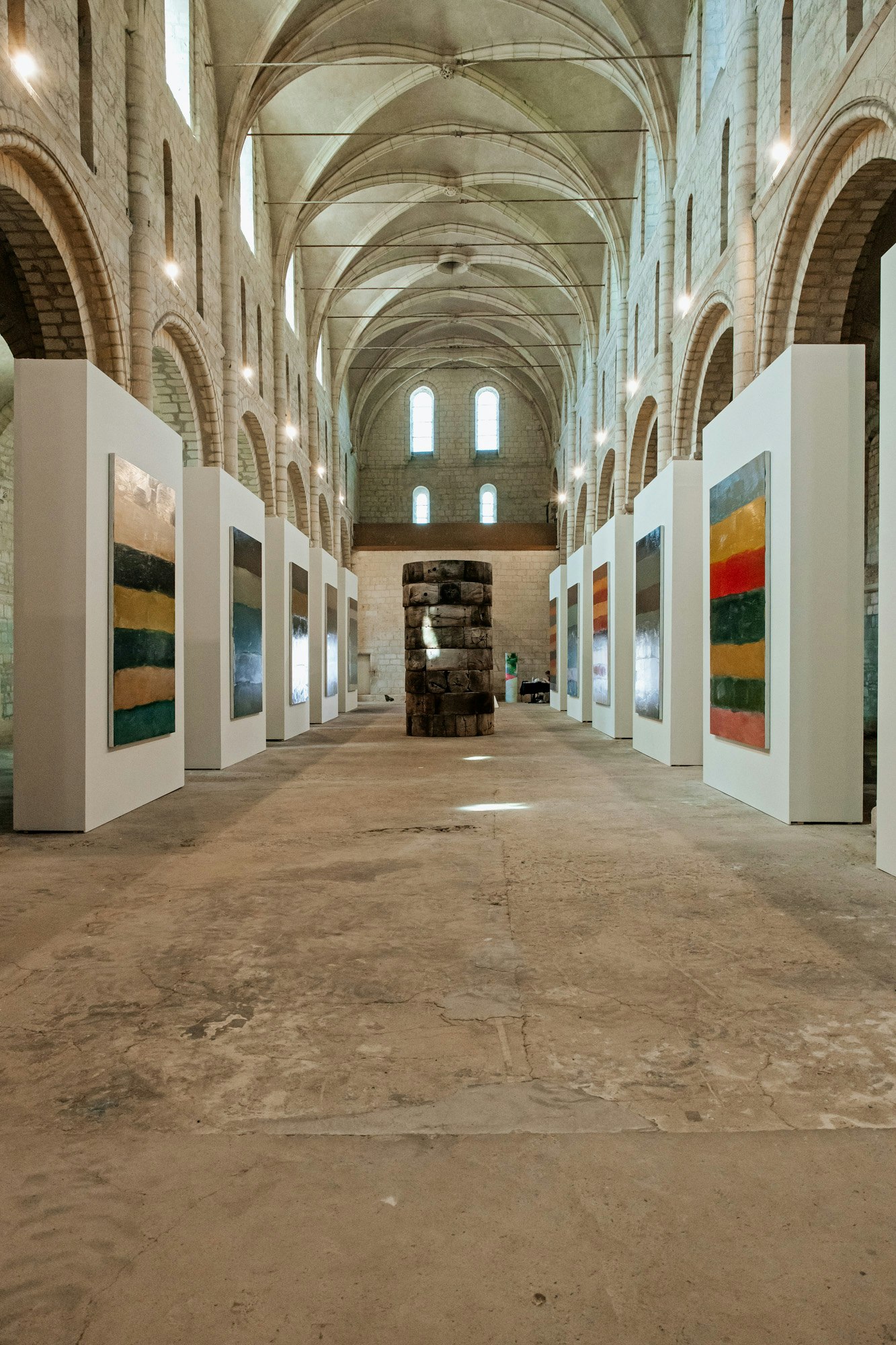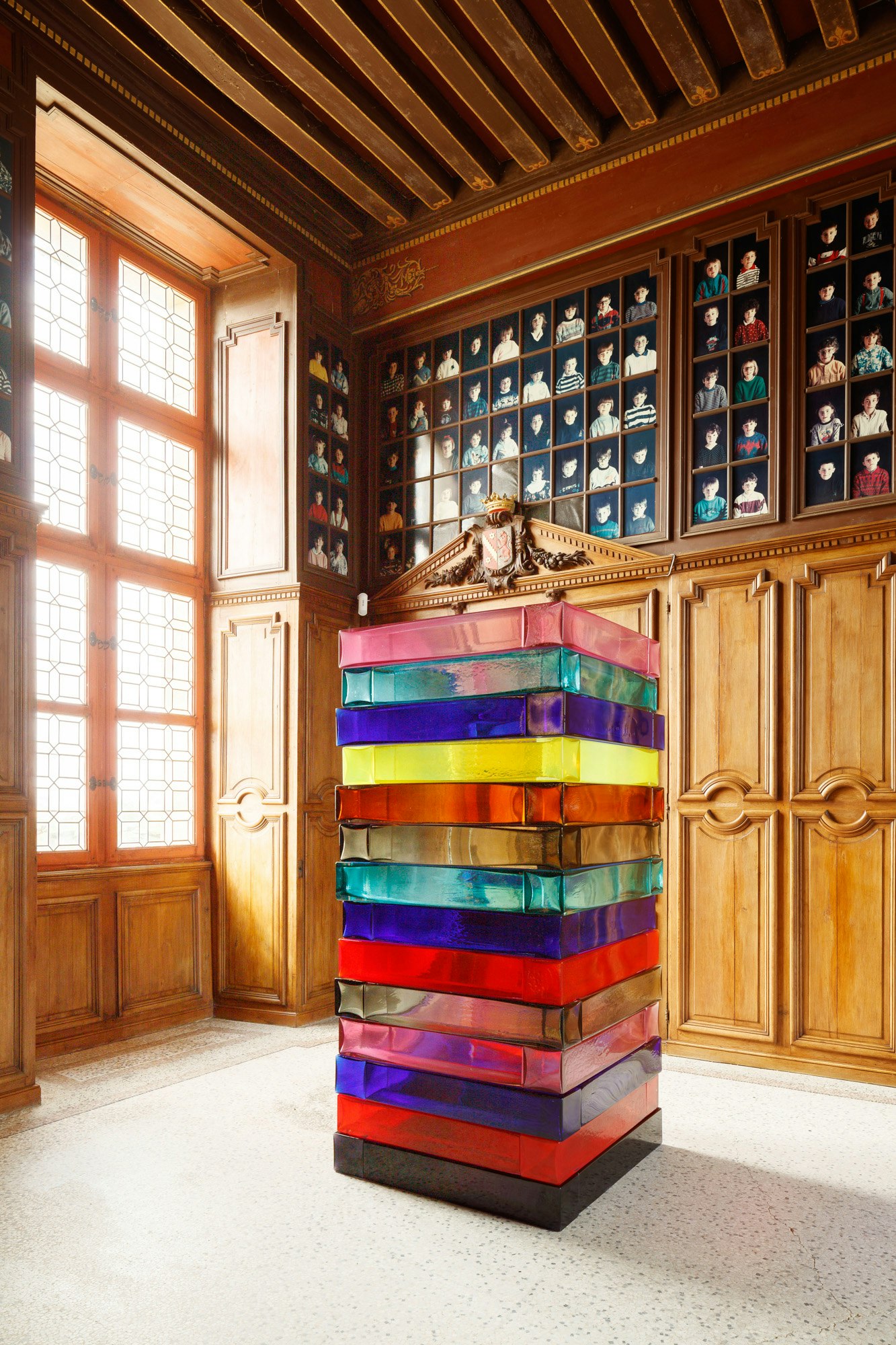This article is taken from the October 2024 issue of The Critic. To get the full magazine why not subscribe? Right now we’re offering five issues for just £10.
At Église Saint-Nicolas, a glorious gothic church in Caen, Britain’s greatest living abstract artist, Sean Scully, is opening his latest one man show. There are loads of people swarming round him — liggers, journalists, local bigwigs — but he seems to tower over them. He’s a big stocky bloke, with the bearlike gait of a nightclub bouncer, but it’s not just his bulk which sets him apart. He looks like a villain in a British gangster movie. Bald and muscular, with a broad grin and a steely stare, you can tell he’s an artist from the wrong side of the tracks.
No other artist divides opinion quite like Sean Scully. He’s renowned on several continents, he’s had acclaimed solo shows in many of the world’s greatest galleries, he’s been showered with honours and awards — yet I’ve met plenty of people who can’t stand his work. He’s a man who excites strong reactions. His followers divide into fans and foes.

For the “anyone could do that” school of art criticism, he’s an easy target. His work looks rudimentary, but its simplicity is deceptive. There’s considerable depth to his paintings. They’re surprisingly complex and a good fit for this monumental Norman church (built from that creamy stone which William the Conqueror shipped to England to construct the Tower of London). Like stained glass windows, his paintings illuminate the sacred architecture of this ethereal, archaic site.
He was born in Dublin in 1945, into a family of travellers. His parents brought him to London when he was a toddler. His father was an Irish barber who went to prison for desertion from the British army. His mother came from a mining family in Durham. Money was scarce. His parents fought like cat and dog. They drifted from rented room to rented room and ended up in Sydenham, a drab South London suburb. He speaks with a strong south London accent. He sounds a lot like Michael Caine.
“I’ve never been normal — even when I was a little kid,” he tells me. “I was driven by something, always bursting with ideas.” He yearned to be an artist from an early age, but he had scant access to art. When he went to Trafalgar Square to feed the pigeons, he had no idea the National Gallery was there. He ran with a street gang, left school at 15, and did a variety of dead-end jobs — welder’s mate, plasterer’s mate, bricklayer’s mate — yet painting kept on calling him. “I was avidly interested in art.”
Working on a building site in Victoria, he spent his lunch hours in the Tate, transfixed by the vivid colours and frenetic brushstrokes of Van Gogh. He fell in love with the gutsy paintings of John Bratby. “I thought they were fantastic. They were so direct and powerful.” He applied to a dozen art schools. They all turned him down, apart from Croydon School of Art.
What if they’d turned him down too? “There’s no way I was giving up,” he states, emphatically. He’s always been blessed with indestructible self-belief.
He was 20 years old, married with a baby boy. Croydon was his last chance, a doorway into another world. “It was paradise from day one. I was the person who appreciated it the most, because I was three or four years older than everybody else. I’d been at work.” Freed from the monotony of unskilled labour, he seized this creative lifeline. From Croydon, he went on to Newcastle University, where he took a First in Fine Art, and won a fellowship at Harvard, then a professorship at Princeton, but it was in New York, painting in a makeshift loft, that he made his name. “I owe New York everything.” In NYC he found his own style and voice.
His early pictures had been precise and intricate, like artworks made by an automaton. In America he broke free from his beginnings, and his soulful side flooded through. “It not only toughened me up — it opened me up,” he says. Most great artists have one big idea. Scully’s big idea was to marry minimalism and expressionism. The fusion of these two contrasting genres resulted in something unique yet instantly recognisable — always the hallmark of a major artist. No collection of modern art is quite complete without one of his moody, enigmatic paintings. Their inscrutability is a big part of their appeal. As he says, “It’s like somebody speaking in a low voice. It’s more interesting than somebody who shouts all the time.”
These minimalist, expressionistic artworks may seem impersonal, but they’re profoundly autobiographical, and that’s what gives them their strange hypnotic power. Their rigid form reflects the poverty of his upbringing. Their dynamism reflects his lifelong urge to break away. Sure, there’s quite a lot of repetition, variations on recurring themes, but many of the best artists plough one furrow, and Scully ploughs it very well.
“I never get fed up painting stripes,” he says. “I could paint stripes for 500 years!”

He’s always been a nomad, roaming between Britain, Europe and America. On the Continent, there’s not the same suspicion of abstraction as there is in Britain, and so he’s spent a lot of time there, especially in Spain and Germany (“their understanding of my work was automatic”). His latest focus is France — not just this show in Caen, but another exhibition at Château d’Oiron, then a new show at the Pompidou Centre in Paris in October. Even as he approaches 80, there’s still something of the traveller about him, full of wanderlust for fresh horizons.
Next morning we drive out to Mont Saint-Michel, but when we get there it’s full of tourists, so we walk back across the causeway to the park and ride. Along the way, Scully opens up about his art and life. He’s emotive and outspoken, with a warm heart and a sharp tongue, far more Irish than English. He has the energy and sensibility of an artist half his age. You can see why he inspires passionate supporters, along with uncompromising critics. He’s not remotely self-effacing. He doesn’t care what people think of him. It’s this fearless candour, almost childlike in its intensity, which makes him a subversive figure, a provocation to the status quo.
Back in his hotel that evening, over dinner, I ask him about his approach to painting. “It’s all emotional,” he says, of his instinctive, intuitive style. “I have no preconceptions about what colours mean.” His best artworks have the opaque beauty of ancient monuments — Celtic crosses, stone circles (one of his most striking shows was a set of photographs of drystone walls). “I want to make something that you think you could have thought of yourself.”
At an age when most artists are slowing down, he’s branching out in new directions. His sculpture shows, at Yorkshire Sculpture Park and Houghton Hall in Norfolk, translated his paintings into rock and metal. The show in Caen translates them into wood and felt, and the effect is equally arresting. “I like sculpture, and I like making things and I made them for myself.”

He’s lived a life full of drama — misery and triumph, extraordinary highs and lows. His first son, Paul, died in a car crash, aged 18 (“I threw the brush down and walked out of the studio — I didn’t come back for three months’). He’s been married four times, lastly, and supremely happily, to the Swiss-Hungarian artist Liliane Tomasko (22 years his junior). He was 64 when their son, Oisin, was born. (“I’ve been given a second chance”). His palette went dark after Paul died. It became light again after Oisin was born.
Oisin also inspired his return to figuration. His bold, expressive triptych in the church in Caen is like an altarpiece, depicting Oisin and Liliane on the beach, a Sagrada Familia.
“The more dangerously you live — and I think I’ve lived very dangerously — the more you’re going to experience,” he says. “I’ve had some serious tragedies in my life. It is like a kind of movie, I guess. It wasn’t my intention, of course, but there is something cinematic about my life. I realise that it has this topsy-turvy quality.” He currently divides his time between New York and London, but he’s a sailor, not a farmer. I feel sure that before long he’ll be on the move again.
The next day, after breakfast, we walk up to the art gallery in Caen’s mediaeval castle, on a hill above the old town. Scully shows me round. His fierce affection for the Old Masters is fuelled by deep and detailed knowledge. “I’ve educated myself on the run, because I left school very young, so my curiosity remains extremely active,” he explains. “I think it’s extremely important to know the history of what you’re doing.” He likens himself to Mike Tyson, studying other boxers, past and present.
“He’s absolutely incredible, isn’t he?” he says, as we stand before a splendid Rubens. “He’s a painter for the great occasion.” His enthusiasm is infectious. He must have been a brilliant teacher. His own work is a reflection of his scholarship. It’s rooted in art history, not remotely avant-garde. His heroes are Fauvists like Derian, not abstract expressionists like Pollock. “He uses an extraordinary range of colour,” he says of Derian, although he could be talking about himself.

We leave Caen and drive 200 miles south to Oiron. It is tiny — a huddle of silent houses, a one-horse town without a horse — but on the green edge of the village is a gigantic château. Inside, Scully has another new show: more of his iconic, geometric paintings. Their austerity is a stark contrast with the baroque décor of this flamboyant building. Although the ornate setting is incongruous, Scully’s pictures seem far more at home here than in a swanky gallery in a big city. Not for the first time, I’m struck by their affinity with landscape painting. Here in Château d’Oiron, they seem at one with the endless fields beyond. That evening there’s a banquet in the château in Scully’s honour. As the party winds down I slip away for a last look at his paintings. Outside, the sun is setting. Alone in this twilit room these artworks feel far more potent than they did before.
Next morning, on the plane back to Britain, Scully is enthusing about the church in Caen. “The building is wonderful,” he tells me. “It’s got ghosts in it, and I like that — all that history, all that carving! And I love stone. I’m crazy for stone, because stone will last.”
What do Scully’s paintings mean? Nothing and everything. There’s no point trying to explain them. The only thing that matters is: would you like to hang one on your living room wall? If I had a living room big enough and the best part of a million pounds to spare, the answer is: yes, I would, and that’s all you need to know.
If you can think of nothing you’d like less, that’s fine. You’re in good company. But if you feel the same way as I do, try to see them in the flesh, ideally in a church or a château rather than a gallery. Photographs do them no justice. They’re textural, three-dimensional. I could gaze at them for hours. For me, it feels a lot like staring out to sea.
Sean Scully is at Thaddaeus Ropac in Seoul from 3 September to 9 November, at Lisson Gallery in New York from 29 October to 21 December, and at the Centre Pompidou, Paris, from 14 October 2024.

